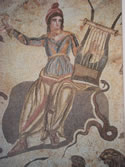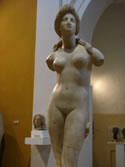

Cyprus: A Mosaic of Travel Options
Text and Photos By Sandra Scott
 The
Republic of Cyprus has a lot in common with the mosaics found in the
2nd century House of Dionysus, an archeological site near Pafos. Both
are colorful with many intricate parts, and a pleasure to view. The
mosaics have all the colors of Cyprus: the blue of the Mediterranean
Sea, the greens of the Troodos Mountains, the browns of the sandy beaches,
and warm colors of the setting sun, plus they represent Cypriot history
that dates back to mythical times.
The
Republic of Cyprus has a lot in common with the mosaics found in the
2nd century House of Dionysus, an archeological site near Pafos. Both
are colorful with many intricate parts, and a pleasure to view. The
mosaics have all the colors of Cyprus: the blue of the Mediterranean
Sea, the greens of the Troodos Mountains, the browns of the sandy beaches,
and warm colors of the setting sun, plus they represent Cypriot history
that dates back to mythical times.
 With
its strategic location in the eastern Mediterranean, Cyprus has been
the crossroads between three continents from the time of Aphrodite.
Cyprus was the first country visited by apostle Paul on his mission
to spread Christianity and crusaders stopped on their way to Jerusalem.
Today tourists enjoy the travel mosaic that is Cyprus marveling at the
sites of antiquity, exploring traditional country villages, and basking
by the Mediterranean Sea.
With
its strategic location in the eastern Mediterranean, Cyprus has been
the crossroads between three continents from the time of Aphrodite.
Cyprus was the first country visited by apostle Paul on his mission
to spread Christianity and crusaders stopped on their way to Jerusalem.
Today tourists enjoy the travel mosaic that is Cyprus marveling at the
sites of antiquity, exploring traditional country villages, and basking
by the Mediterranean Sea.
An historical mosaic
 People
have been living the good life in Cyprus for centuries. The large, palatial
House of Dionysus shows the level of wealth during the Roman era. It
is so named because one of the many mosaics depicts Dionysus, the god
of wine. At the Neolithic settlement of Choirokoitia, dating back to
6800 BC, there are reconstructed round stone huts that give evidence
to a relatively sophisticated lifestyle at an even earlier time.
People
have been living the good life in Cyprus for centuries. The large, palatial
House of Dionysus shows the level of wealth during the Roman era. It
is so named because one of the many mosaics depicts Dionysus, the god
of wine. At the Neolithic settlement of Choirokoitia, dating back to
6800 BC, there are reconstructed round stone huts that give evidence
to a relatively sophisticated lifestyle at an even earlier time.
 Just
as intriguing are the sites associated with Aphrodite, Venus in Roman
mythology. At a breathtakingly beautiful spot on the Mediterranean coast
between Lemesos and Pafos is where legend has it that Aphrodite, the
goddess of love, emerged from the sea. West of Polis is the grotto Aphrodite
used for secret trysts with her many lovers. Cyprus is an open-air museum
that will intrigue both the history buff and the causal tourist. The
magnificent amphitheater at Kourion, the Tomb of Kings, St. Paul’s
Pillar, medieval castles, and frescoed Byzantine churches are just part
of the mosaic of the past. Currently Cyprus has three UNESCO World Heritage
sites with other sites on the waitlist, plus new archeological discoveries
being unearthed on a regular basis.
Just
as intriguing are the sites associated with Aphrodite, Venus in Roman
mythology. At a breathtakingly beautiful spot on the Mediterranean coast
between Lemesos and Pafos is where legend has it that Aphrodite, the
goddess of love, emerged from the sea. West of Polis is the grotto Aphrodite
used for secret trysts with her many lovers. Cyprus is an open-air museum
that will intrigue both the history buff and the causal tourist. The
magnificent amphitheater at Kourion, the Tomb of Kings, St. Paul’s
Pillar, medieval castles, and frescoed Byzantine churches are just part
of the mosaic of the past. Currently Cyprus has three UNESCO World Heritage
sites with other sites on the waitlist, plus new archeological discoveries
being unearthed on a regular basis.
A coastal mosaic
 Exploring
the antiquities are a perfect diversion for sun worshipers but the beaches
are the main draw. With four hundred miles of coastline, there is a
beach for everyone. Forty-nine of the country’s beaches have been
awarded the exclusive Blue Flag, an eco-label given to beaches that
maintain high environmental standards. Visitors can chose from campsites
on the beach to tourist resorts to temples of luxury that would please
Aphrodite.
Exploring
the antiquities are a perfect diversion for sun worshipers but the beaches
are the main draw. With four hundred miles of coastline, there is a
beach for everyone. Forty-nine of the country’s beaches have been
awarded the exclusive Blue Flag, an eco-label given to beaches that
maintain high environmental standards. Visitors can chose from campsites
on the beach to tourist resorts to temples of luxury that would please
Aphrodite.
 Resorts
are truly full-service offering a plethora of water sports, golf, hiking,
biking, diving, horse riding, tennis courts, spas, and even skiing.
At certain times of the year it is possible to ski in the morning, golf
in the afternoon, and spend the night at the disco. All resorts are
close to one of the coastal cities, which offer shopping, museums, dining,
and theme parks. Keeping in mind that Aphrodite is the goddess of love
and Cyprus is where Richard the Lionheart married Berengaria in the
12th century, Cyprus ranks high on the list of the world’s most
popular destinations for weddings and honeymoons. Luxury resorts like
Aphrodite Hills, Le Meridien, and Anassa have onsite chapels plus there
are a plethora of churches with exquisite Byzantine artwork that make
a perfect setting for a wedding.
Resorts
are truly full-service offering a plethora of water sports, golf, hiking,
biking, diving, horse riding, tennis courts, spas, and even skiing.
At certain times of the year it is possible to ski in the morning, golf
in the afternoon, and spend the night at the disco. All resorts are
close to one of the coastal cities, which offer shopping, museums, dining,
and theme parks. Keeping in mind that Aphrodite is the goddess of love
and Cyprus is where Richard the Lionheart married Berengaria in the
12th century, Cyprus ranks high on the list of the world’s most
popular destinations for weddings and honeymoons. Luxury resorts like
Aphrodite Hills, Le Meridien, and Anassa have onsite chapels plus there
are a plethora of churches with exquisite Byzantine artwork that make
a perfect setting for a wedding.
A pastoral mosaic
 Visitors
looking for respite from the beach or city can relish the gentle pace
of life in the countryside. Only an hour away from any part of the island,
the Troodos Mountains, home to Mount Olympus and at 6400 feet the highest
point on the island, are home to painted Byzantine churches listed as
UNESCO’s World Heritage sites. Plus there are traditional villages
with cobbled streets to wander, wine tasting at vineyards and serenity
that is seldom found in today’s manic world. Cyprus has an agrotourism
program that encourages restoration of traditional houses making them
fully equipped to receive guests. It is a great way to get in harmony
with Cypriot life style, stop to smell the jasmine, enjoy the nature
trails, visit historical monasteries, and chat with the locals at the
local taverna.
Visitors
looking for respite from the beach or city can relish the gentle pace
of life in the countryside. Only an hour away from any part of the island,
the Troodos Mountains, home to Mount Olympus and at 6400 feet the highest
point on the island, are home to painted Byzantine churches listed as
UNESCO’s World Heritage sites. Plus there are traditional villages
with cobbled streets to wander, wine tasting at vineyards and serenity
that is seldom found in today’s manic world. Cyprus has an agrotourism
program that encourages restoration of traditional houses making them
fully equipped to receive guests. It is a great way to get in harmony
with Cypriot life style, stop to smell the jasmine, enjoy the nature
trails, visit historical monasteries, and chat with the locals at the
local taverna.
A capital mosaic
 Dating
back 1000 years, the capital Lefkosia (Nicosia) is both old and new.
It is the commercial and business heart of the country. Located in the
middle of the island, the city was once enclosed by a star-shaped Venetian
fortress wall and moat. The moat is often the site of concerts and the
old city is a restored pedestrian area with shops and restaurants. The
mosaic of Lefkosia is comprised of palm tree-lined streets, modern shops,
mosques, beautiful frescos in St. John’s Cathedral, a museum with
Byzantine icons, and the must-see Cyprus Museum. The museum has the
best collection of archeological artifacts including terra cotta figures
that predate those in China and the sublimely beautiful 2000-year-old
statue of Aphrodite. At the Handicraft Center the artistic heritage
is preserved and promoted by bringing craftsmen together in one location.
Visitors can watch artisans weaving, producing leather articles, fashioning
pottery, and creating other traditional items, plus purchase authentic
items from the shop.
Dating
back 1000 years, the capital Lefkosia (Nicosia) is both old and new.
It is the commercial and business heart of the country. Located in the
middle of the island, the city was once enclosed by a star-shaped Venetian
fortress wall and moat. The moat is often the site of concerts and the
old city is a restored pedestrian area with shops and restaurants. The
mosaic of Lefkosia is comprised of palm tree-lined streets, modern shops,
mosques, beautiful frescos in St. John’s Cathedral, a museum with
Byzantine icons, and the must-see Cyprus Museum. The museum has the
best collection of archeological artifacts including terra cotta figures
that predate those in China and the sublimely beautiful 2000-year-old
statue of Aphrodite. At the Handicraft Center the artistic heritage
is preserved and promoted by bringing craftsmen together in one location.
Visitors can watch artisans weaving, producing leather articles, fashioning
pottery, and creating other traditional items, plus purchase authentic
items from the shop.
A gastronomic mosaic
 With
its crossroads position in the Mediterranean, Cypriots have added an
exotic flavor to their cuisine creating a unique dining experience.
The best way to sample the mosaic of Cypriot food is with a meze, which
means “little delicacies.” Meze is a meal of as many as
30 small plates of food, from savory dips and vegetables to a wide range
of fish and meat dishes. It is enjoyed “siga, siga” (slowly,
slowly) taking time to savor such delectable dishes as octopus in red
wine, traditional grilled cheese, smoked sausages, and other dishes
served with salad, fresh baked bread, and wine.
With
its crossroads position in the Mediterranean, Cypriots have added an
exotic flavor to their cuisine creating a unique dining experience.
The best way to sample the mosaic of Cypriot food is with a meze, which
means “little delicacies.” Meze is a meal of as many as
30 small plates of food, from savory dips and vegetables to a wide range
of fish and meat dishes. It is enjoyed “siga, siga” (slowly,
slowly) taking time to savor such delectable dishes as octopus in red
wine, traditional grilled cheese, smoked sausages, and other dishes
served with salad, fresh baked bread, and wine.
Pharaohs consumed it and King Solomon waxed lyrical about Cypriot wines.
Commandaria is considered the oldest named wine dating to the 12th century.
Wine enthusiasts will love Cyprus where wine making goes back to 2000
BC. There are winery tours and annual festivals plus a wine museum near
Lemesos (Limassol).
Explore the mosaics
 Out
of all the islands of the Mediterranean, it is no surprise that Aphrodite
chose to live on Cyprus. Today European vacationers often return to
Cyprus to retire. For such a small island country there is something
in the mosaic of Cyprus to tickle the fancy of every visitor. Connections
to Greece, Egypt, and the Middle East are quick and convenient. One
of the many tour options offered travel agents is a day trip to Alexandria,
Egypt. Cyprus is a tourist-friendly, four-season destination, where
English is widely spoken, and excellent roads make it easy to get around
keeping in mind that driving is on the left. For more information check
www.visitcyprus.org.cy.
Out
of all the islands of the Mediterranean, it is no surprise that Aphrodite
chose to live on Cyprus. Today European vacationers often return to
Cyprus to retire. For such a small island country there is something
in the mosaic of Cyprus to tickle the fancy of every visitor. Connections
to Greece, Egypt, and the Middle East are quick and convenient. One
of the many tour options offered travel agents is a day trip to Alexandria,
Egypt. Cyprus is a tourist-friendly, four-season destination, where
English is widely spoken, and excellent roads make it easy to get around
keeping in mind that driving is on the left. For more information check
www.visitcyprus.org.cy.
Search the Web for related information on the Cyprus
Home | North
America | South & Central America | Europe
Asia & Middle East | Africa
| Oceania | Favorite
Accommodations
Travel Images Blog
| Preferred
Accommodations Blog
Travel Blog | Columns
| About Sandra | Contact
Sandra | Site Map
Copyright
© 2002-2007 Sandra Scott. ALL RIGHTS RESERVED
Site
designed and created by C.F. Howley